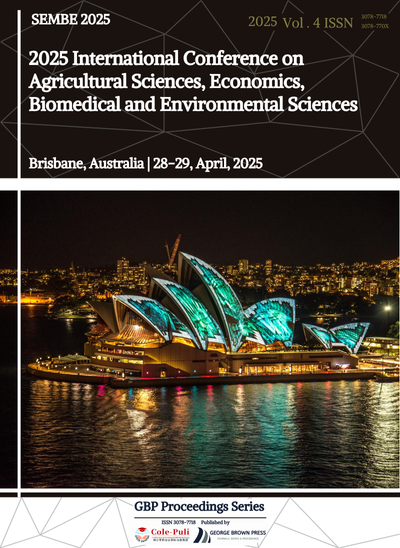Progress of Deficit Mulched Drip Irrigation for Potatoes
DOI:
https://doi.org/10.71222/gggxzr08Keywords:
drip irrigation under membrane, potato, yield, water use efficiencyAbstract
Submembrane drip irrigation offers several key benefits, including efficient water and fertilizer usage, strong adaptability to various environments, a reduction in pest and disease pressures, and increased crop yield and income. Research shows that this irrigation method can reduce water consumption by over 80%, enhance land use efficiency, decrease labor requirements, and improve water resource utilization. This paper examines the development and application of sub-film drip irrigation for potato cultivation under controlled deficit irrigation conditions. The goal is to enhance potato yield, improve quality, and optimize water usage efficiency, ultimately contributing to increased productivity and economic benefits for agricultural production.
References
1. D. Horton, Potatoes: Production, Marketing, and Programs for Developing Countries. Boca Raton, FL, USA: CRC Press, 2019. ISBN: 9780429302756.
2. H. Zhang, X. U. Fen, W. U. Yu, H. H. Hu, and X. F. Dai, “Progress of potato staple food research and industry development in China,” J. Integr. Agric., vol. 16, no. 12, pp. 2924–2932, 2017, doi: 10.1016/S2095-3119(17)61736-2.
3. K. Zaheer and M. H. Akhtar, “Potato production, usage, and nutrition—a review,” Crit. Rev. Food Sci. Nutr., vol. 56, no. 5, pp. 711–721, 2016, doi: 10.1080/10408398.2012.724479.
4. M. Kalimullin et al., “Improvement of potato cultivation technology,” in IOP Conf. Ser.: Earth Environ. Sci., vol. 346, no. 1, p. 012017, Oct. 2019, doi: 10.1088/1755-1315/346/1/012017.
5. Y. Liu et al., “Impact of extended dryland crop rotation on sustained potato cultivation in Northwestern China,” Resour. Con-serv. Recycl., vol. 197, p. 107114, 2023, doi: 10.1016/j.resconrec.2023.107114.
6. H. Zhao et al., “Plastic film mulch for half growing-season maximized WUE and yield of potato via moisture-temperature improvement in a semi-arid agroecosystem,” Agric. Water Manag., vol. 104, pp. 68–78, 2012, doi: 10.1016/j.agwat.2011.11.016.
7. G. V. Rambabu, P. Bridjesh, N. P. Kishore, and N. S. Sai, “Design and development of a drip irrigation system,” Mater. Today Proc., 2023, doi: 10.1016/j.matpr.2023.06.349.
8. J. P. Venot et al., “Beyond the promises of technology: A review of the discourses and actors who make drip irrigation,” Irrig. Drain., vol. 63, no. 2, pp. 186–194, 2014, doi: 10.1002/ird.1839.
9. A. Gulati et al., “Israeli agriculture—Innovation and advancement,” in From Food Scarcity to Surplus: Innovations in Indian, Chinese and Israeli Agriculture, pp. 299–358, 2021. ISBN: 9789811594830.
10. H. Li et al., “Performance of a drip irrigation system under the co-application of water, fertilizer, and air,” Horticulturae, vol. 10, no. 1, p. 6, 2023, doi: 10.3390/horticulturae10010006.
11. H. Xu and R. Yang, “Does agricultural water conservation policy necessarily reduce agricultural water extraction? Evidence from China,” Agric. Water Manag., vol. 274, p. 107987, 2022, doi: 10.1016/j.agwat.2022.107987.
12. L. Fang and L. Zhang, “Does the trading of water rights encourage technology improvement and agricultural water conser-vation?” Agric. Water Manag., vol. 233, p. 106097, 2020, doi: 10.1016/j.agwat.2020.106097.
13. Y. Xing and X. Wang, “Precision agriculture and water conservation strategies for sustainable crop production in arid regions,” Plants, vol. 13, no. 22, p. 3184, 2024, doi: 10.3390/plants13223184.
14. Y. She et al., “Evaluating losses from water scarcity and benefits of water conservation measures to intercity supply chains in China,” Environ. Sci. Technol., vol. 58, no. 2, pp. 1119–1130, 2024, doi: 10.1021/acs.est.3c07491.
15. M. A. Badr, E. Ali, and S. R. Salman, “Effect of nitrogen application and fertigation scheduling on potato yield performance under drip irrigation system,” Gesunde Pflanzen, vol. 75, no. 6, pp. 2909–2918, 2023, doi: 10.1007/s10343-023-00871-y.
16. R. Huffaker, “Conservation potential of agricultural water conservation subsidies,” Water Resour. Res., vol. 44, no. 7, 2008, doi: 10.1029/2007WR006183.
17. G. Zhao et al., “Effects of subsurface drip fertigation on potato growth, yield, and soil moisture dynamics,” Front. Sustain. Food Syst., vol. 8, p. 1485377, 2024, doi: 10.3389/fsufs.2024.1485377.
18. Y. Cao, H. Cai, S. Sun, X. Gu, Q. Mu, W. Duan, and Z. Zhao, “Effects of drip irrigation methods on yield and water productivity of maize in Northwest China,” Agric. Water Manage., vol. 259, p. 107227, 2022. doi: 10.1016/j.agwat.2021.107227.
19. J. Yin et al., “Irrigation scheduling for potatoes (Solanum tuberosum L.) under drip irrigation in an arid region using AquaCrop model,” Front. Plant Sci., vol. 14, p. 1242074, 2023, doi: 10.3389/fpls.2023.1242074.
20. M. Akkamis and S. Caliskan, “Responses of yield, quality and water use efficiency of potato grown under different drip irri-gation and nitrogen levels,” Sci. Rep., vol. 13, no. 1, p. 9911, 2023, doi: 10.1038/s41598-023-36934-3.
21. L. Goel, V. Shankar, and R. K. Sharma, “Influence of different organic mulches on soil hydrothermal and plant growth pa-rameters in potato crop (Solanum tuberosum L.),” J. Agrometeorol., vol. 22, no. 1, pp. 56–59, 2020, doi: 10.54386/jam.v22i1.123.
22. Y. Zhang et al., “Effects of film mulching and soil wetted percentage of drip irrigation on soil hydrothermal conditions and sweet potato growth,” Eur. J. Agron., vol. 151, p. 126979, 2023, doi: 10.1016/j.eja.2023.126979.
23. S. A. Buldakov, N. A. Shakleina, and L. P. Plekhanova, “Cultivation method for revitalized potato material in the system of original seed production,” in IOP Conf. Ser. Earth Environ. Sci., vol. 845, no. 1, p. 012019, Nov. 2021, doi: 10.1088/1755-1315/845/1/012019.
24. R. K. Panda, S. K. Behera, and P. S. Kashyap, “Effective management of irrigation water for maize under stressed conditions,” Agric. Water Manage., vol. 66, no. 3, pp. 181–203, 2004, doi: 10.1016/j.agwat.2003.12.001.
25. S. Ijaz-ul-Hassan, A. Khan, and S. Erum, “Effect of deficit drip irrigation on yield and water productivity of potato crop,” Int. J. Agric. Ext., vol. 9, no. 2, pp. 239–244, 2021, doi: 10.33687/ijae.009.02.3528.
26. G. Kavianand, V. M. Nivas, R. Kiruthika, and S. Lalitha, “Smart drip irrigation system for sustainable agriculture,” in 2016 IEEE Technol. Innov. ICT Agric. Rural Dev. (TIAR), 2016, pp. 19–22, doi: 10.1109/TIAR.2016.7801206.
27. S. Kasirajan and M. Ngouajio, “Polyethylene and biodegradable mulches for agricultural applications: a review,” Agron. Sus-tain. Dev., vol. 32, pp. 501–529, 2012, doi: 10.1007/s13593-011-0068-3.











